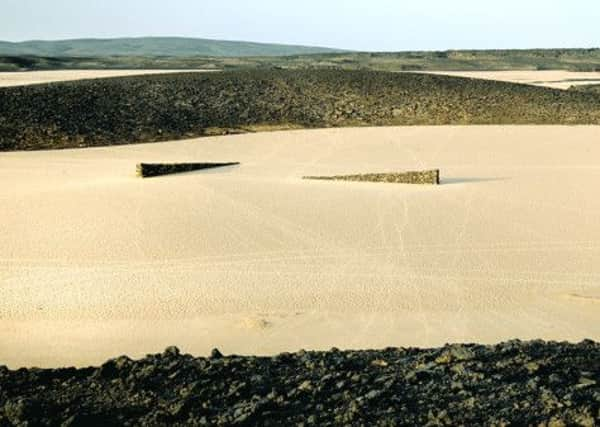Art review: Julie Brook, made unmade, Dovecot Studios, Edinburgh


The view of the Knoydart wilderness on the mainland is stunning under the bluest of skies. The waters of the Sound of Sleat are dancing in the sunlight. We are enthusiastically greeted by the household in this order: a dog, Brook herself, two laidback cats, two of her four children (impeccably polite) and her husband, film producer Chris Young.
I have my own children with me: we had been flicking through TV channels the week before and by coincidence had spotted Julie’s seven-year-old daughter Meredith making drawings with her mum on a children’s art programme. They want to meet her.
Advertisement
Hide AdAs they peel off into the garden, where there are dens to be explored, tree swings to be swung, I’m beginning to think I’m not such an urbanite after all. Perhaps life in the wilder places might be good. Brook smiles wryly; it’s been 15 years since she settled here, leaving Glasgow where she lived in the 1990s: “It took about five years to come to terms with it because it was so unwild.”
Wild places are Julie Brook’s passion. She first came to attention as a landscape painter and sculptor whose dedication to the Isle of Jura was such that in 1991 she set up home on a beach under a remote sea arch and a painting studio on the open hills.
Next week she opens a major new show at Dovecot in Edinburgh. It is inspired by work made, and materials collected, on her travels in the last five years, first exploring the Sahara desert in Southern and Central Libya and then two trips to remote sites in Namibia, in 2011/12.
“It’s about having the courage,” she says. “In Libya, in 2008, when I first set out, I had no clue who my guides would be and we had no shared language. I was terrified about the heat. But your courage just takes hold of you and the most amazing stuff unravels.”
In Namibia she was three days from the capital Windhoek, driving on dirt roads and meeting people in occasional settlements and scattered dwellings. With the permission of locals she made and photographed a number of interventions in the landscape, carving a ragged river bank into a seamless wall of red clay, and building a cube of drystane dyke from scattered stones.
Brook is not afraid of wielding a pickaxe or a spade, nor of travelling alone with local guides and camping in dry river beds. “I work really hard, I don’t insist on help, but it makes a difference when I work with local guys. You just have to trust.”
Advertisement
Hide AdBrook, 51, is rangy: lean and very tall. Her blonde hair is cropped and feathery, and she is dressed in jeans, a fleece and stout walking boots. In the converted barn that serves as an airy studio, she shows me the sequences of drawings that will form a core part of the show along with immersive installation of the films she made of her landscape art works. The drawings, which have inspired a hand-tufted rug made by the Dovecot’s specialist weavers, are based on the interventions she made in the Namibian landscape, but they are also made out of it.
In the Kunene region of north-west Namibia the Himba people mine iron oxide and use the red dust to coat their body and plaited hair. Brook filmed Himba women at work and collected the ore herself to make into pigment for her studio. Brook was no mere observer; as well as filming she mined some of the stuff, then back in Skye pounded it to form cakes of pigment. She shows me the rock-hard compound in its original form. “It’s like breaking stones, you get covered in the stuff,” she says.
Advertisement
Hide AdThe Himba tradition seems both practical and symbolic. If the pigment serves as sun protection not unlike modern mineral-based skincare, it also relates to the Himba way of life as nomadic cattle-herders in far deeper ways. For Brook, “the practical aspects of all our lives are so magical when we choose to observe it”.
It was this magic she found living wild and making art in Jura. She had discovered the island after art school at the Ruskin in Oxford. When she met Chris, she says, “it was so sweet, sometimes he would have to walk for four-and-a-half hours across the island to meet me. I remember one day saying, ‘Why on earth do people need houses?’ He burst out laughing.”
These days they do have a house and a family. After many years in the film and TV business, Young was brought in to help sort out the Channel 4 show called The Inbetweeners, the rest is history and the movie he produced in 2011 became a remarkable box office hit.
They have a lively home and workplace that seems magical to my children. “A Himba head man came to me when I was making the Red River Bank and he said to my guide, ‘So in fact you’re just playing like children’. As an artist you have to be like a child, not in the infantile sense, but in the sense of experimentation. You have to be playful. You are wanting to keep that part of yourself really alive.”
Before we leave, Brook invites my daughters into the studio. She shows them how the Namibian pigment is applied to the paper using her fingers. Soon they are all coated in fine red dust. Even in the most tranquil domestic setting Julie Brooks likes to be reminded of wild places.
Twitter: @moirajeffrey
• Julie Brook, made unmade is at Dovecot Studios, Edinburgh, Saturday until 1 June. juliebrook.com, dovecotstudios.com.